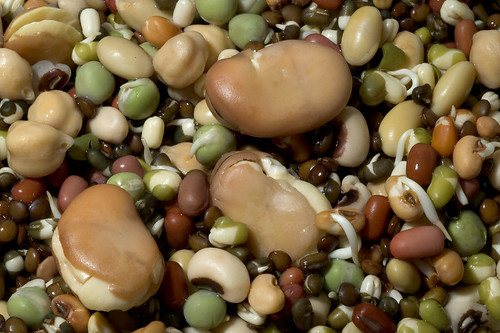!!! My website has
moved: please update your bookmarks to debunix.net !!!
Kwati, a curried sprouted bean soup
This is a wonderful traditional soup
from the Himalayas. After I started to read about it, I
discovered several variation on the net. The common threads are
the use of a variety of beans including some lentils and peas, that
they be sprouted before cooking, and that it is a curry. This
recipe is from the Joys of Nepalese Cooking, by Indra Majupuria, a
wonderful little treasure I found in a used bookstore. There it
is called “Hot Beverage of Pulses and Beans”, or Kwati,
from Nepal. It is made for a religious festival. And it is
so beautiful to make that it inspired the series of photos below.
If you have a pressure cooker, it works beautifully for this recipe, but it is not required.
Makes 4-6 servings
Take a total of 2 cups of a mix of these whole dried beans, lentils and peas to sprout (about 1/4 C each):
Lentils
Urad or black mung beans
Green mung beans
Peas
Cowpeas
Black eyed peas
Fava beans
Adzuki beans
Soybeans
Chickpeas (garbanzos)
2 teaspoons mustard oil
1-2 onions, finely chopped
2 garlic cloves
1 teaspoon fenugreek seeds (methi)
2 bay leaves
1 teaspoon turmeric powder
2 teaspoons cumin powder
1 teaspoon coriander powder
Ginger, about 1 inch, peeled and grated
1 teaspoon chili powder
3/4 teaspoon salt
Good stock if you have it, water if not, about a quart (chicken stock was very fine)
Ajwain seeds
Ghee or vegetable oil, 1-2 tsp
Fresh cilantro, for garnish
Soak the beans,
peas and lentils in water for at least 24 hours. Drain and keep
in a warm place for about 24 hours, until they’ve begun to
sprout. Wash again before cooking.
In the pressure
cooker it you’re using it, in a stockpot if not, saute the onion
in the mustard oil. When translucent and beginning to turn
golden, add the garlic, bay leaves, and fenugreek seeds. When the
onions are golden, add the sprouted beans and saute briefly before
adding the spices and stock. Simmer until the beans are soft
(30-45 minutes in a stock pot, 15 minutes under pressure in the
pressure cooker.
Fry the ajwain
seeds in ghee or oil until they blacken. Stir into the finished
soup and let sit a few minutes to meld the flavors.
One suggested variation includes chopped spiced meat wrapped in a dough, dropped and cooked in the soup as dumplings.
Note on the beans:
The beans
suggesed appear to be commonly available in the Himalaya, but not all
are easy to find here in the U.S. Another version I found
suggested an easier mix of kidney beans, black-eyed beans, chickpeas,
soy beans, mung beans, green beans, black beans, white beans, and red
beans.
Here is the original list from Majupuria’s recipe:
*Masur or lentil (Lens culinaries)--whole, not halved [indian brown lentils with the red interior?]
*Maas or urad
(Vigna mango)-- whole, not halved [vinga mungo are black gram or black
mung-type beans, “a species which produces small black seeds with
a fine taste”]
*Mungi (Vigina radiata/Phaseolus aureus)-- whole, not halved [green mung beans]
*Field pea (Sano
Kerao-Pisum arvenese) small and large varieties [field pea
googles up as your basic split pea, unsplit; sano kerao yields nothing;
pisum arvense looks like little beige beans, hmm—guessing the
basic dried whole green peas are a good start, but the “small and
large” varieties remain a puzzle; and why would thse be
listed separately from ‘peas or kerau’ below?]
*Cow pea or bodi
(Vigna catjang) [this one is hard to parse out: black eye peas,
or vigna unguiculata is called “bodi” in the caribbean and
“catjang” in India per grainslegumes.com, but vigna catjang
is a different squarish tan-brown bean; I’m going with the black
eyed peas]
*Simi (Solichus
labla) white and red varieties [googling suggests possibly mucuna
pruriens, a small squarish tropical bean with an oddly prominent eye,
which comes in speckled, black, and brown varieties]
*Bakula (broad bean) (Vicia faba) [favas]
*Masyung (Siltung) Phaseolus calcaretus [looks to be adzuki beans, based on the latin, and the others yield nothing on googling]
*Bhatmas (soyabean, Glycine max: few seeds) [soybeans]
*Peas or kerau (Piscium sativum var arvense) [looks like smooth skinned beige whole dried peas]
*Gram seeds (chana) Siser arietinum, whole, not halved [should be cicer arietinum, your basic chickpea]
And the pictures (whole set on flickr: http://farm1.static.flickr.com/94/234457418_e389310b31.jpg:
Before sprouting:

Sprouted, ready to cook:

The finished soup:

Return
to Recipe Index
Return
to Diane's Food Page
Return to Diane's Home Page


